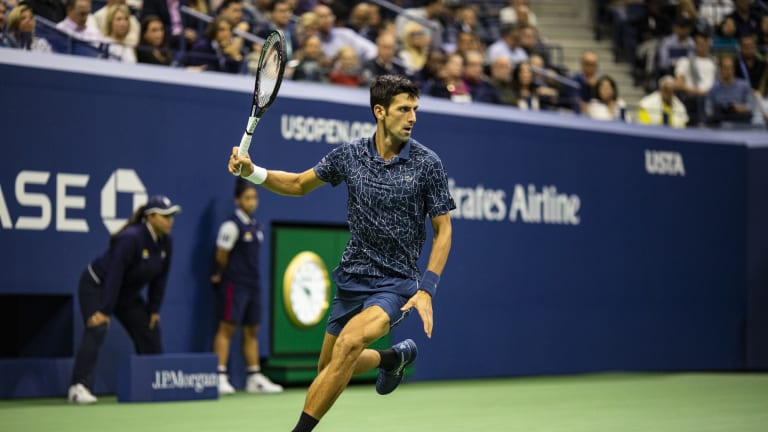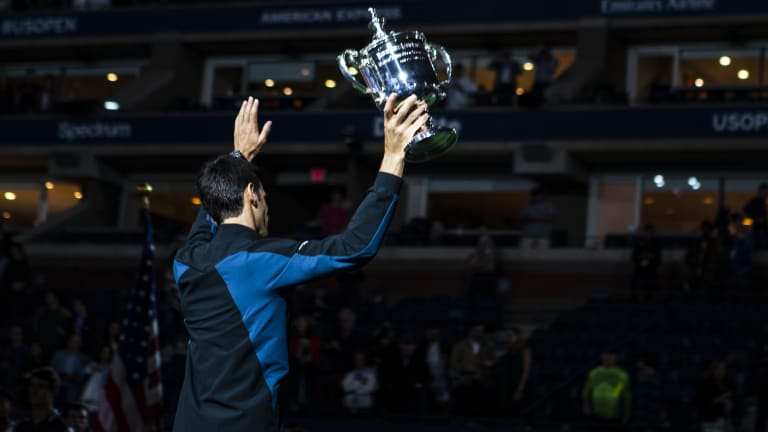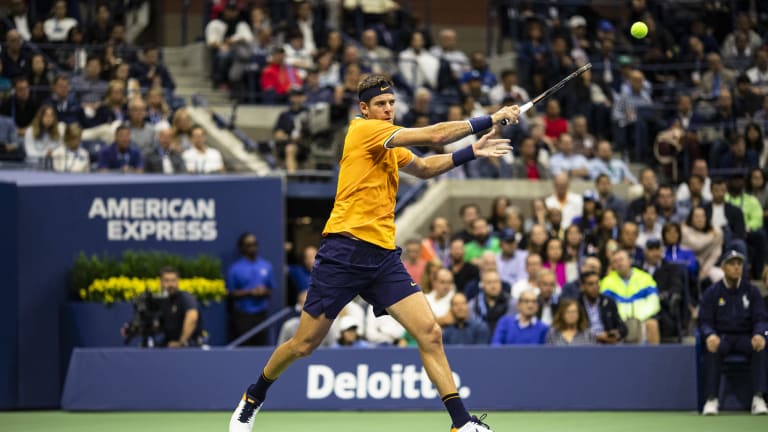Highlights—Novak Djokovic defeats Juan Martin del Potro in the US Open final:
What does Novak Djokovic's return to invincibility mean for the game?
By Steve Tignor Sep 10, 2018Wimbledon
Debating best-of-three sets vs. best-of-five
By Steve Tignor May 21, 2021Wimbledon
The Tennis Conversation: Tim Henman
By Matt Fitzgerald May 21, 2021The Pick: Lorenzo Musetti vs. Sebastian Korda, ATP Lyon second round
By Cale Hammond May 18, 2021In Geneva, Roger Federer loses clay-court comeback to Pablo Andujar
By John Berkok May 18, 2021The Pick: Jannik Sinner vs. Aslan Karatsev, ATP Lyon first round
By Cale Hammond May 17, 2021Officials deny that 2022 Australian Open could move
By Kamakshi Tandon May 17, 2021Week in Preview: Serena, Federer lead stars tuning up for French Open
By Steve Tignor May 17, 2021Nadal finds the final answer for Djokovic in roller coaster Rome final
By Steve Tignor May 16, 2021Rafael Nadal battles past Novak Djokovic to win Rome for 10th time
By John Berkok May 16, 2021What does Novak Djokovic's return to invincibility mean for the game?
novak djokovic 14th grand slam us open del potro
Published Sep 10, 2018
Advertising
After Novak Djokovic's 6-3, 7-6 (4), 6-3 win over Juan Martin del Potro in the US Open final, Steve Tignor and Joel Drucker discussed the Serb’s return to invincibility, and what it means for the men’s game.
Advertising
Steve,
What an end to this summer of Slams. I well recall us sitting next to one another in Paris, watching Novak Djokovic lose in the quarterfinals of Roland Garros to 72nd-ranked Marco Cecchinato. Djokovic wasn’t just beaten that day. He was downright sloppy, his footwork and technique betraying him on a number of big points.
And now here he is, champion of Wimbledon and the US Open in the same year—Djokovic’s 14th Slam, tied with his childhood hero, Pete Sampras. Combine this with Naomi Osaka’s win over Serena Williams and it was quite a weekend for idol worship turned into glory.
In taking three hours and 16 minutes to earn this 6-3, 7-6 (4), 6-3 victory, Djokovic demonstrated superb craftsmanship this evening. It was quite clear that a key part of his game plan was to go after the Del Potro forehand, be it with wide serves in the deuce court, T serves in the ad court and plenty of crosscourt forehands. Time after time, Djokovic absorbed Del Potro’s big hits and let his excellent set of wheels repeatedly carry him through the rallies. Even more precisely, Djokovic’s balance and recovery is exquisite—remarkably disciplined and flawlessly executed.
The other part of Djokovic’s plan was to return serve deep and down the middle of the court. These often threw del Potro on his heels, making it hard for him to generate angles.
In the second set tiebreaker, serving at 5-4, Djokovic orchestrated a fantastic 17-ball point worthy of a tennis lesson. Deep drives off both sides, but hardly flirting with the sidelines, kept del Potro pinned—and eventually elicited an error off Del Potro’s forehand, an exceptionally demoralizing occurrence for the Argentine. The final point of that 95-minute set also saw Djokovic probe wisely, this time ending a seven-ball rally with a wide crosscourt forehand that pulled Del Potro wide to his forehand and resulted in a drive into the net.
Steve, what do you think have been the keys to Djokovic’s summer resurgence?

What does Novak Djokovic's return to invincibility mean for the game?
© Anita T Aguilar
Advertising
Photos by Anita Aguilar
Joel,
This was fundamental, old-school, borderline-unbeatable Djokovic. By the end, it was was as if his two-year dry spell had never happened at all. He dropped a set in each of his first two matches, to Marton Fucsovics and Tennys Sandgren, and then didn’t drop another.
By the end of the tournament, all of the old Djokovic elements were in place again. The heavy serve out wide in the deuce court. The uncanny ability to put so many returns at or near the baseline. The solid ground strokes from both sides. And the speedy, rubbery movement that sets him apart from virtually all of his peers, including Del Potro. Djokovic essentially clinched the match in the second-set tiebreaker simply by making Del Potro hit too many forehands. From 4-4 in the breaker, Delpo missed three straight forehands for the set. Djokovic doesn’t miss those shots, because he doesn’t need to go for as many winners. With his speed and stamina, he can always wait one shot longer.
Despite the straightforward scoreline, tonight we also saw Djokovic’s trademark need to either endure—or manufacture—some adversity along the way. Even when he’s winning, he’s generally unable to make it through three sets without hitting some sort of speed bump. Either he gives back a service break, or gets annoyed at the crowd, or demands that his player box give him more support, or just doesn’t like the way he’s hitting the ball for a few games. It seems like Djokovic functions best when he has a hurdle to clear—adversity energizes him.

What does Novak Djokovic's return to invincibility mean for the game?
© Anita T Aguilar
Advertising
Up a set and a break against Del Potro, Djokovic got a little tight; this isn’t unusual when a player reaches that stage. He gave the break back, let Delpo and his vocal fan club into the match for the first time, and nearly lost the set. Only a 20-minute service hold at 3-4 kept Djokovic from having to start over at one-set all. Then, in the third set, Djokovic went up 3-1 and had a game point for 4-1; Delpo appeared to be on his last legs. But for some reason, Djokovic chose that moment to serve and volley. He lost the point, lost his break, and the set was soon tied at 3-3.
All of that may sound counterproductive, and not the way we think most champion athletes’ minds work. But to me, Djokovic’s willingness to court adversity has been the difference in his game this summer. On the court, Djokovic has a reputation for being “clinical” in victory, and off the court he has searched for ways to find a more peaceful equilibrium in his life. In reality, though, he has always won by going to war with himself, and externalizing that struggle. In Indian Wells and Miami he was still injured. During the clay season he was finding his feet and fitness. At Roland Garros and Queen’s, he wasn’t quite ready mentally to close out matches that he should have won. To me, he finally reached fifth gear when he beat Kei Nishikori in the quarterfinals at Wimbledon, in a match that he played on an emotional knife edge. That emotion was the final ingredient to his comeback.
This win leaves Djokovic with 14 majors. It must be particularly satisfying because he has lost five US Open finals; if he had won just two of those matches—like, say, against Andy Murray in 2012 or Stan Wawrinka in 2016—he would be within one of Rafael Nadal’s total of 17 Slams. I guess the next question is: Even after a two-year drought, does Djokovic catch Nadal and Federer in the major count?

What does Novak Djokovic's return to invincibility mean for the game?
© Anita T Aguilar
Advertising
Steve,
Ah, to think that when the year started we figured the Slam tally race was all about a program best called, “The New Adventures of the Old Roger and Rafa Show.” And now, here’s Novak, his two-Slam ’18 his version of what Federer and Nadal each did last year. Maybe this one: “Welcome Back, Novak.”
In the game of Big Three Billiards, I know this could earn me anger from the Federer and Nadal lovers. But in raw tennis terms, Novak—at least right now—is in a better place technically, tactically and physically than either of his two main rivals. Besides being six years younger than Federer, Djokovic is healthier than both the Swiss and the recently injured Nadal.
If we look at this in mathematical terms, Djokovic is 31. Given that 31 these days in tennis can be considered new 27, he likely has at least two if not three years of superb tennis ahead of him—12 Slams. To win four seems viable. To win more—well, that is less about Federer or even about Nadal, but more a question of which other contenders have the skill and will to step up. Del Potro will turn 30 later this month. Then there are such young guns as Alexander Zverev, Stefanos Tsitsipas, Denis Shapovolov, Hyeon Chung, Borna Coric, Lucas Pouille and others (including some who have yet to even crack the Top 30). Those talents have had their flurries at smaller events but have yet to make major statements at the Slams.

What does Novak Djokovic's return to invincibility mean for the game?
© Anita T Aguilar
Advertising
But as was the case in June 2016, the world right now belongs to Djokovic. It’s amazing how all that appeared absent over the last two years now seems tidily in order. Djokovic is a supreme practitioner of contemporary, attrition-based baseline tennis, patrolling the court in a way that’s efficient and sustainable. And yet, to have seen him play so poorly this spring and then transform himself reveals so much about the mysteries of tennis. How did all that happen, both the bad and the good?
Right now, we are mostly in the conjecture stage. Was the problem in Novak’s elbow? What did he fix in his mind? What insights—words, drills, tactics—did his coach, Marian Vajda, bring to the table when they rejoined forces earlier this year? Which matches during those years in the desert did Novak learn most from—some horrible losses or a resurgent win?
So let’s look at it this way, Steve: What kind of array of tools do you think are required now for beating Djokovic at a major? Is there a single player you believe has these tools? Or would you like to amalgamate weapons from others to construct player who doesn’t yet exist?
An interview with the US Open champion, Novak Djokovic:
Advertising
Joel,
You’re right that Djokovic, after giving up significant ground in the Grand Slam title race over the last two years, suddenly looks to be in a very good position compared to Federer and Nadal. Federer is 37 and could retire as early as next year. Just as important, now that Djokovic is back at full strength, Federer’s chances of adding to his 20-major count become significantly slimmer. As for Nadal, Djokovic is three titles behind him, but he should have the advantage at three of the four Slams going forward. Most intriguing will be Roland Garros, where Djokovic does own a win over Rafa. How big will the stakes be if they meet in the final in Paris next year? Here’s a prediction: Federer, Nadal, and Djokovic—who are ranked 1, 2, and 3 again, by the way—will each end up with 20 Grand Slam titles.
As for someone who could challenge Djokovic in the future, a person who fits that description should, theoretically, exist. Nadal and Federer have beaten him at least 20 times each, and Stan Wawrinka has had major successes against him. But who among the younger set has what it takes to challenge Novak regularly? So far, Zverev can’t get far enough at a Slam to play him. Shapovalov has the weapons, but he’s still raw and prone to wild swings in form. Chung did it at the Australian Open, and Tsitsipas did it in Toronto, but do we expect either of them to repeat those performances on a regular basis? Nick Kyrgios has the game, and occasionally the mentality, to beat Djokovic; but how often will he go deep enough at a major to face him?
Djokovic will probably be slowed not by any player, but by the normal ups and downs of a career, especially a career that has reached its 30s. Federer went through a four-year Slam drought from 2013 to 2016; Nadal failed to win any in 2015 and 2016; and Djokovic just reemerged from two years in the wilderness. The time away has left him hungrier, but who’s to say when another injury won’t sideline him again?
Advertising

What does Novak Djokovic's return to invincibility mean for the game?
© Anita T Aguilar
For now, Djokovic is overjoyed to be back on the mountaintop. Is his re-ascendance is good for tennis? Federer has said that he believes it is, and I agree. There was something weird about seeing the ghost of Djokovic make his brief appearances at Indian Wells and Miami this spring. Tennis is stronger when its best players are living up to their potential, and when the guys who can make history are making history.
For me, there was something satisfying about seeing Djokovic struggle his way through that crucial, never-ending, 95-minute second set against Del Potro on Sunday night. It wasn’t pretty. The games were long and wearying. There were plenty of errors on both sides, plenty of ads handed back and forth. Djokovic was angry at the pro-Delpo crowd, and Delpo was doubled over in exhaustion. But Delpo had the momentum, and there were a lot of moments when it looked as if Djokovic was going to lose, especially when he faced three break points in a 20-minute game at 3-4.
At that stage, every one of Del Potro’s winners was being greeted with a thunderous roar from the top of the arena. Yet I had a feeling Djokovic, alone again on the stage, would find a way through, someway, somehow. That’s what he always done, and that’s what he did on Sunday night. He has found his level again, and no one can match it.